Tattoos in The Arctic & Alaska
The inhabitants of St. Lawrence
Island in the Bering Sea have a tattoo history dating back over 3,500 years.
|
|
Tattooing was an important tool in helping individuals deal with the harsh
environment and appeasing their gods. Artic tattooing was an important part of
the hunter-gatherer economy of the north.
|
Archeological evidence in the form of carved human figurines demonstrates that
tattooing was practiced as early as 3,500 years ago in the Arctic.
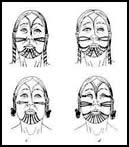 Tattooing was practiced by all Eskimos and was most common among women. An early
reference was made by Sir Martin Frobisher in 1576. Frobisher's account
describes the Eskimos he encountered in the bay that is now named after him:
Tattooing was practiced by all Eskimos and was most common among women. An early
reference was made by Sir Martin Frobisher in 1576. Frobisher's account
describes the Eskimos he encountered in the bay that is now named after him:
The women are marked on the face with blewe streekes down the cheeks and round
about the eies… Also, some of their women race (scratch or pierce) their faces
proportionally, as chinne, cheeks, and forehead, and the wristes of their hands,
whereupon they lay a colour; which continueth dark azurine."
As a general rule, expert tattoo artists were respected women elders. Their
extensive experience as skin seamstresses (parkas, pants, boots, boat covers,
etc.) facilitated the need for the type of precision that was needed to produce
tattoos. Tattoo designs were usually made freehand but in some instances a rough
outline was first sketched.
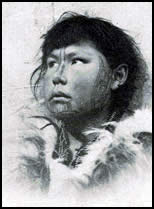 A description of the tattooing process among the Central Eskimo living near Daly
Bay (Hudson Bay) is:
A description of the tattooing process among the Central Eskimo living near Daly
Bay (Hudson Bay) is:
The wife had her face tattooed with lamp-black and is regarded as a matron in
society. The method of tattooing is to pass a needle under the skin, and soon as
it is withdrawn its course is followed by a thin piece of pine stick dipped in
oil and rubbed in the soot from the bottom of the kettle. The forehead is
decorated with a letter V in between the eyes almost to the bridge of the nose,
and sloping gracefully t the right and left before reaching the roots of the
hair. Each cheek is adorned with an egg-shaped pattern, commencing near the wing
of the nose and sloping upward toward the corner of the eye; these lines are
also double. The most ornamented par, is the chin, which receives a gridiron
pattern; the lines double from the edge of the lower lip, and reaching to the
throat towards the corners of the mouth, sloping outward to the angle of the
lower jaw.
Around Bering Strait, the tattooing method reveals continuity in application.
The St. Lawrence Island Yupiget tattoo artist drew a string of sinew thread
through the eye of a steel or bone needle. The thread was continually soaked in
a liquid pigment of lampblack, urine and graphite. The needle and sinew were
drawn through the skin: as the needle was inserted and pushed just under the
epidermis about a thirty-second of an inch.
A typical tattoo required a number of sittings with the tattoo artist and each
session would be accompanied by pain, swelling, infection and even death.
Inuit (or Eskimos generally) and St. Lawrence Island Yupiget, in particular,
regarded living bodies as inhabited by multiple souls, each soul residing in a
particular joint. Tattoos have significant importance in funerary events,
especially on St. Lawrence Island. Funerary tattoos consisted of small dots at
the convergence of various joints: shoulders, elbows, hip, wrist, knee, ankle,
neck and waist joints. For applying them, the female tattooist, in cases of both
men and women, used a large, skin-sewing needle with whale sinew dipped into a
mixture of lubricating seal oil, urine, and lampblack scraped from a cooking
pot. Lifting a fold of skin she passed the needle through one side and out the
other, leaving two ‘spots' under the epidermis.
First-kill tattoos (kakileq) consisted of small dots at the convergence of
various joints: shoulders, elbows, hip, wrist knee, ankle, neck and waist.
Tattoos were considered a conduit for a ‘visiting' spiritual entity to come from
‘beyond' into the contemporary world. Tattoos and other types of adornment acted
as magnets attracting a spiritual force - one that was channelled through the
ceremonial attire and into the body.
On St. Lawrence Island both men and women tattooed anthromorphic spirit-helpers
onto their foreheads and limbs. St. Lawrence men had a number of different
circular tattoos around the mouth to prevent them from drowning.
Circles were also important in Bering Strait culture, especially when speaking
about life and death encounters at sea.
Men and women were also tattooed on each upper arm and underneath the lip with
circles, half-circles, or with cruciform elements at both corners of the
disguise the wearers from disease-bearing spirits.
Women's Facial and Body Tattoos
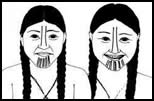 There seems to have been no widely distributed tattoo design among Eskimo women,
although chin stripes (tamlughun) were commonly found than any other. Chin
stripes served multiple purposes in social contexts. Most notably, they were
tattooed on the chin as part of the ritual of social maturity, a signal to men
that a woman had reached puberty. Chin stripes also served to protect women
during enemy raids.
There seems to have been no widely distributed tattoo design among Eskimo women,
although chin stripes (tamlughun) were commonly found than any other. Chin
stripes served multiple purposes in social contexts. Most notably, they were
tattooed on the chin as part of the ritual of social maturity, a signal to men
that a woman had reached puberty. Chin stripes also served to protect women
during enemy raids.
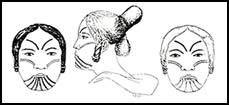 The chin stripe was important to Diomede Islands living in Bering Strait.
Ideally, thin lines tattooed onto the chin were valuable indicators for choosing
a wife. A full set of lines was a statement of the woman's ability to endure
great pain but also an attestation to a woman's powers of "animal" attraction.
In the St. Lawrence and Chaplino Yupik area of the early 20th century, women
painted and tattooed their faces in ritual ceremonies in order to imitate,
venerate, honor, and/or attract those animals that "will bring good fortune" to
the family.
The chin stripe was important to Diomede Islands living in Bering Strait.
Ideally, thin lines tattooed onto the chin were valuable indicators for choosing
a wife. A full set of lines was a statement of the woman's ability to endure
great pain but also an attestation to a woman's powers of "animal" attraction.
In the St. Lawrence and Chaplino Yupik area of the early 20th century, women
painted and tattooed their faces in ritual ceremonies in order to imitate,
venerate, honor, and/or attract those animals that "will bring good fortune" to
the family.
Slightly sloping parallel lines, usually consisting of three tightly grouped on
the face, were also tattooed on women.
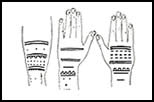 Tattoos were placed on girls 6 to 10 years of age. Tattoos also marked the
thighs of young St. Lawrence Island women when they reached puberty. In Igloolik,
in Canada, the tattooing of women's thighs ensured that the first thing a
newborn infant saw would be something of beauty.
Tattoos were placed on girls 6 to 10 years of age. Tattoos also marked the
thighs of young St. Lawrence Island women when they reached puberty. In Igloolik,
in Canada, the tattooing of women's thighs ensured that the first thing a
newborn infant saw would be something of beauty.
Intricate scrollwork found on the cheeks and tattoos on the arms of women say
these tattoos beautify their bodies.
THE UNANGAN, ALUTIIQ, AND CHUGACH OF ALASKA
In 1741, the German-born Georg Wilhelm Steller became the first European to
describe the Native peoples of Alaska, the Unangan or Aleuts on the Shumagin
Islands.
For the inhabitants of these windswept islands, labrets, piercing, and tattoos
were symbolically tied to the most sacred realms of cultural experience. Body
art was created not only to lure, please, and honor the spirits of animals; it
also increased the social status, spiritual power, and beauty of the adorned.
Traditionally, the term "Aleut" was used by Russian fur-traders to describe the
indigenous peoples they met. Today, the Unangan (who speak the Aleut language),
Alutiiq (Kodiak Islanders), and the Chugach of Prince William Sound see
themselves as distinct from one another culturally and linguistically and
designate themselves accordingly. With the invasion of the Russians in the 18th
century, each group was gradually enslaved and organized into a force to labor
for the Russian fur-based empire.
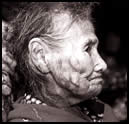 Whether fuelled by the Russian distaste of the "hideous" customs of tattooing and
piercing or the Christian missionary's efforts to eradicate aspects of dress,
grooming, and ritual they found "deplorable" and "savage," body piercing,
labrets and tattoos were rarely seen after 1820.
Whether fuelled by the Russian distaste of the "hideous" customs of tattooing and
piercing or the Christian missionary's efforts to eradicate aspects of dress,
grooming, and ritual they found "deplorable" and "savage," body piercing,
labrets and tattoos were rarely seen after 1820.
Interestingly, some men of the Aleutian archipelago were "brought up entirely in
the manner of girls, and instructed in all the arts women use to please man:
their beards are carefully plucked out as soon as they begin to appear, and
their chins are tattooed like those of the women." Whether mothers and fathers
dreaded the loss of their sons in war or while hunting at sea, several accounts
describe transgendered individuals. On Kodiak Island in 1790, Sarychev saw
"among the arriving Kodiaks there was a 40 year-old, ugly fellow, clad in
woman's garb; his face was tattooed and there were beads in his nose. This man
played the role of a wife for a young islander and did all the woman's work."
Davydov stated that these people were known as akhutshcik "and are mostly
magicians" or shamans.
When an Aleut woman experienced her first menses she received her first tattoo
and among some Inuit groups men received their first tattoos and labrets after
having killed their first animal.
Bodily modification was a visual cue by which individuals could evaluate one
another, especially if placed on the face. In a study of 186 societies that
practiced polygamy, like the traditional Aleut, Low found that men who scarified
themselves were likely to acquire more than one wife. Ludvico and Kurland
concluded in a 1995 study that tattooing had the same effect, "because such
women are assumed to be more willing to endure pain to please their lover and to
cope successfully with the pain of childbirth."
Aleut adornment consisting of nose rings, labrets, and tattoos were natural
symbols simultaneously linking nature, society, and culture into one aspect.
Tattoo Museum Bibliography, Resources and Links
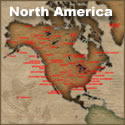 See all North American Tattoo Culture Articles here
See all North American Tattoo Culture Articles here
See these Lars Krutak articles
Tattoos of the early hunter-gatherers of the Arctic,
PIERCING AND PENETRATION: BODY ARTS OF THE UNANGAN, ALUTIIQ, AND CHUGACH OF ALASKA
and The Last Tattoos of St. Lawrence Island, Alaska
for more information about tattoos, tattooing and piercing in the Arctic.
NEXT >>
First Nations
